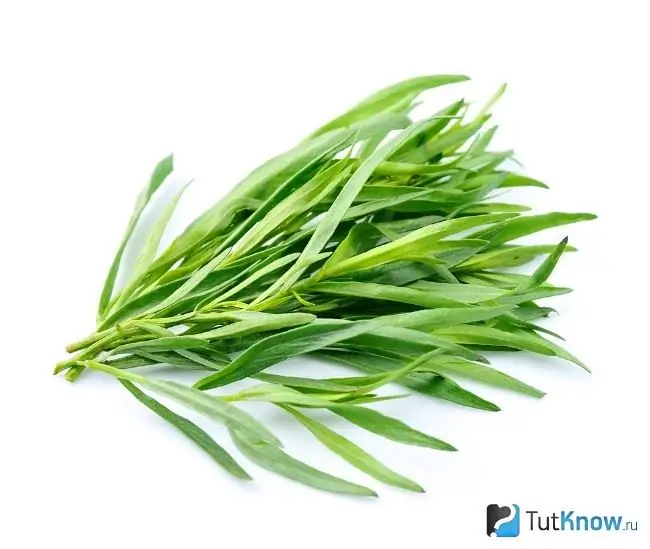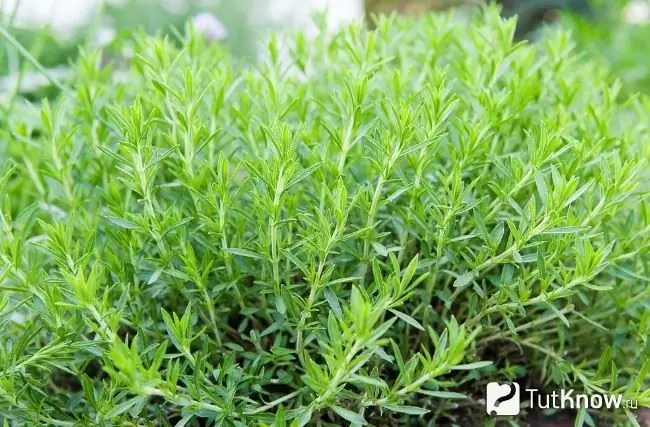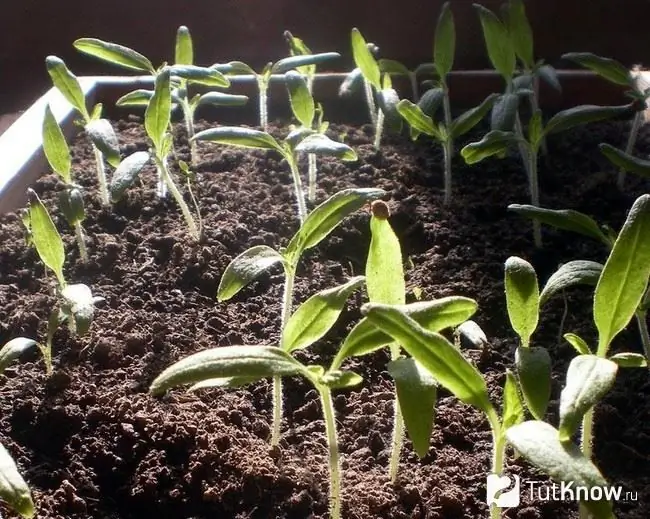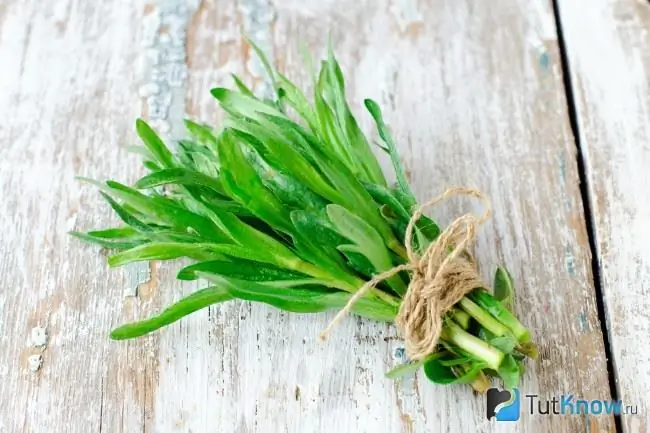- Author Arianna Cook [email protected].
- Public 2024-01-12 17:55.
- Last modified 2025-06-01 07:38.
With tarragon, pickles and tomatoes, fish dishes are tastier! Learn how to grow tarragon and you will always have this plant at hand. The eastern spice tarragon has been known for a long time. If you want to grow it in your country house, it is enough to plant tarragon seeds, this is how I call tarragon in another way. Tarragon is a perennial herb belonging to the Wormwood group. It is used in canning, in various pickles, as a seasoning for meat and fish dishes, added to tea, prepared soft drinks, vodka is infused on it, balsam and wine are made.
Tarragon stems and leaves contain a lot of essential oil, vitamin C, rutin, carotene. In medicine, tarragon is used for stomach cramps, to increase appetite, as an anti-inflammatory and antiseptic.
Botanical description of tarragon

This spice grows in the form of a bush with a woody rhizome. Tarragon has few stems, can reach a height of 40 to 150 cm. Leaves are linear or oblong-lanceolate, pointed. The flowers are pale yellow, collected in panicles. Tarragon blooms in August-September, and the fruits ripen by October.
Growing tarragon seedlings

Tarragon reproduces:
- seeds;
- dividing the bush;
- cuttings;
- root suckers.
If you decide to grow this perennial in your garden plot, you can plant seeds of varieties:
- French;
- Russian;
- Gribovsky 31.
If you want to propagate tarragon by seeds, then it is best to grow it through seedlings, since the seeds germinate for a long time and in the open field you may never see the long-awaited sprouts.
Tarragon seeds are sown in containers with light soil in February or early March. They are embedded in moist soil to a depth of 3 mm, covered with foil and placed in a warm place. Seedlings will appear only on the 25-30th day, so you need to monitor the soil moisture by wetting it from a spray bottle. If there is strong condensation on the film, it is lifted for ventilation.
When sprouts appear, containers are placed on a light windowsill. Seedlings dive when they are one month old. If this period falls on the beginning of May, you can plant the plants in a greenhouse. Before planting, you need to break off the tips of the roots so that this part of the tarragon grows well.
If you decide to plant tarragon seeds immediately in the ground, then this should be done immediately after the snow melts, deepening them by 1 cm and covering them with a film on top. When shoots appear, it is removed.
After a month, the seedlings will get stronger, then they can be planted in a permanent place, preferably in a two-tape way, keeping the distance between the ribbons 40-50 cm, between the rows 40 cm, and between the plants in a row - 20-30 cm.
Reproduction of tarragon by dividing the bush and cuttings

Cuttings 20 cm long are cut at an acute angle, leaving 4 cm of the stem after the bottom pair of leaves. Having processed the cut with the drug "Kornevin", they are planted in loose soil under a film or in a greenhouse. This is best done in early spring or late summer.
After about a month, rooting will occur. The cuttings are planted in a permanent place next spring, keeping the distance between the plants 70x70 or 60x60 cm. Tarragon is propagated by dividing the rhizomes when the bush is 4-5 years old, in late summer or early spring. Since the root system of tarragon is shallow, the plant must be dug out very carefully so as not to damage the small roots.
It is also necessary to act carefully, separating the root offspring from the main plant, after which it is planted in the prepared area. This is the best breeding method for tarragon. In early spring, several root plants are separated from two- or three-year-old bushes and planted in the soil at a distance of 60? 60 or 50? 50 cm, shading until survival.
Planting and caring for tarragon

Tarragon is a light-loving plant, but if you plant it in partial shade, it will feel good here too, however, the taste of tarragon in darkened areas decreases. The plant prefers sandy loam soils, on heavy ones you need to add sand, organic fertilizers in the form of humus or compost. Tarragon does not like acidic soils, they need to be limed in advance or added in the spring before planting ash. The spice does not like stagnant water, so ridges need to be made in such areas.
So that tarragon does not lose its famous aroma, you do not need to overfeed it with nitrogen fertilizers. When digging for 1 sq. m. beds add 1-2 tbsp. l. double superphosphate and 1 tbsp. l. potassium salt. In order for some of the nitrogen to leave peat or compost, it is better to apply these organic fertilizers under tarragon during autumn plowing.
Planting care consists in watering, destroying weeds, feeding, which must be given from the second year of plant life after planting. To do this, in early spring, it is necessary to add 50 g of complex mineral fertilizer, and after cutting the greens, pour the infusion of fermented grass in a ratio of 1:10, mullein (1:10) or chicken droppings in a ratio of 1:20 on wet ground.
Tarragon is watered infrequently - 2-3 times a month. As the greenery grows, it is cut off. This is done when it reaches 10-12 cm. Do not cut the greens under the root, you need to leave a 12-15 cm "stump". In August, cutting is stopped to allow the plants to grow stronger before winter.
In mid-September, lignified shoots should be cut off, leaving a 6 cm high "stump", feed the tarragon with phosphorus and potassium fertilizers and scatter 3 kg per 1 square meter around the plant. m. humus or peat.
The greens are consumed immediately, stored in the refrigerator or dried in the shade, tied in bunches. To preserve the taste, color and smell of tarragon, you need to do this for a short time. To do this, use warm ventilated rooms or a vegetable dryer.
After the greens have dried, the leaves are separated from the stems, crushed with a coffee grinder. Store in jars, tightly closed with lids for 1-2 years.
Diseases and pests of tarragon

If brown pads appear on the tarragon, then this is a disease called rust. The resulting spores spill out as they ripen and can be carried by the wind to still healthy plants. Rust causes tarragon leaves to wither and dry out. It most often appears with a thickened planting and on plants that are provided with excess nitrogen nutrition.
In order to prevent the appearance of this disease, it is necessary to remove, by burning, plant residues, observe agricultural techniques, weed in time and cut the greens in a timely manner.
Tarragon pests are aphids, leafhoppers, wireworms. You can get rid of aphids by using folk non-chemical remedies. For this, tarragon is sprayed with infusions of onion husks, green tops of potatoes or tobacco.
Of the group of leafhoppers in the Russian central zone, the most widespread are leafhoppers-pennies. So they are nicknamed due to the fact that they emit a foamy liquid around them. Not only adult insects are dangerous, but also the larvae in that they suck out the juice of the leaves, as a result of which the leaves become ugly. To prevent leafhoppers from annoying, you need to remove weeds in a timely manner. After all, it is from them that pests move to tarragon. You need to deal with them as follows: pollinate the plants with fluff lime or tear off damaged leaves.
The wireworm damages the roots of young plants, while it does not do much harm to adults. Deep loosening of the soil and liming will help protect against it.
These are the control measures that will help if the plant is attacked by a pest or a disease appears. And even novice gardeners can grow it, the main thing is to adhere to simple rules and believe in yourself!
For more information on growing tarragon, see this video:






